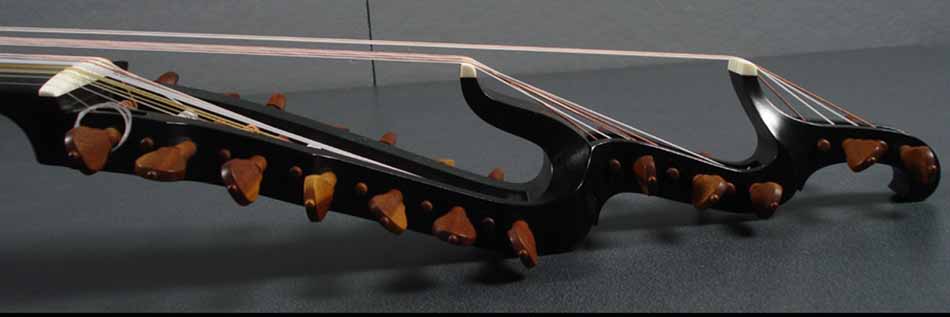A Vihuela for Eugene
Eugene Braig- fishery biologist, guitar and mandolin aficionado, and Artisitic Director for the Columbus Guitar society, http://columbusguitarsociety.org/ -brought me a vihuela to work on.
It was clearly constructed to a guitar-like concept. A massive bridge with saddle and placed approximately in the center of the lower bout. The fingerboard was elevated and blended into the soundboard at the join. I have found similar qualities including the figured maple back and the identical color of shellac-finish on instruments by Hans Jordan, although this one had no label. It may have been produced early in his career or by someone following his example.
I removed the top and found a soundboard that was braced like a modern guitar, yet very crudely and heavily. There were some inlaid bits of spruce between the main braces. We decided that it should be replaced with appropriate barring.
Another feature I have found In Jordan's instruments is dovetailed necks. The heel is "dovetailed" into the neckblock. here is the image on the left.
The lute pictured here also has the dovetailed neck feature and is labeled Hans Jordan. The bars on the lute, however, were a little more carefully executed. A lot of time was spent on this joint. Interestingly, As the case with the Jordan lute, there is no real improvement on original lute design/model. His lute was in my shop to repair the neck that had "come up" revealing air between the neck body joint.
Of course, the neck was back angled to accept the height of the saddled bridge, which we hoped to replace with a more appropriate unsaddled bridge. Tuning pegs were also thick ebony shanks that were hopeless. The only thing seemingly decent, at this point was the shell, the back and sides. The shell was beautiful curly Acer pseudoplatanus or common European maple. With so much to our dismay, we decided on a total rebuild, keeping only the shell and fingerboard.
This sort of work has been done before. Our ancestors would take a bowl and re-use it, building a more modern concept onto it, and I believe that is what I have done here. The difference here is, what was lost or changed, I don't expect to be missed by future generations, judging by the completed instrument's aesthetic and vastly improved sound, there is just no comparison.
For Instance, I replaced a crudely cut rosette with this rose. I copied this design from the Stradivarius guitar The Rawlins in the National Music Museum in South Dakota. This is not a guitar, but I believe roses transcend their accompanying instruments and a fair design for the vihuela.
I moved the bridge position lower down the soundboard and subsequently had to increase the string length to maintain the tenth fret, neck side of the body join. Luckily, I was able to shorten the new pegbox so all would still fit in the case. The original pegbox left a little to be desired, see images above. I set to work on a new set of pegs and designed a slightly curved, yet simple pegbox.
For Instance, I replaced a crudely cut rosette with this rose. I copied this design from the Stradivarius guitar The Rawlins in the National Music Museum in South Dakota. This is not a guitar, but I believe roses transcend their accompanying instruments and a fair design for the vihuela.
I moved the bridge position lower down the soundboard and subsequently had to increase the string length to maintain the tenth fret, neck side of the body join. Luckily, I was able to shorten the new pegbox so all would still fit in the case. The original pegbox left a little to be desired, see images above. I set to work on a new set of pegs and designed a slightly curved, yet simple pegbox.
The instrument still has the body outline described by it's original design and Eugene expressly requested to keep the original lateral peg layout, he believes the aesthetic is derived from this painting.
In the end, it was worth the effort. I'm happy to say Eugene and I are pleased with the result. I spent the better part of last weekend playing through some lute music. I have yet to learn the upside down tablature for this instrument.
Finally, the completed instrument.
Finally, the completed instrument.
You'll have to excuse a couple of these photographs. I didn't notice until later that the fourth course had popped out it's position in the nut.



